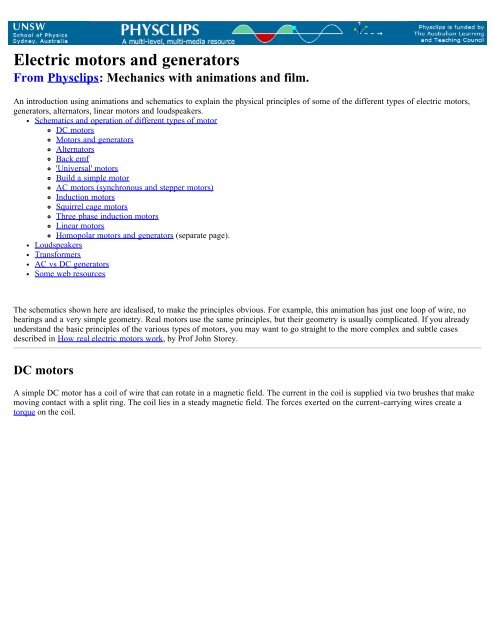How real electric motors work - School of Physics - The University of ...
How real electric motors work - School of Physics - The University of ...
How real electric motors work - School of Physics - The University of ...
You also want an ePaper? Increase the reach of your titles
YUMPU automatically turns print PDFs into web optimized ePapers that Google loves.
Electric <strong>motors</strong> and generators<br />
From Physclips: Mechanics with animations and film.<br />
An introduction using animations and schematics to explain the physical principles <strong>of</strong> some <strong>of</strong> the different types <strong>of</strong> <strong>electric</strong> <strong>motors</strong>,<br />
generators, alternators, linear <strong>motors</strong> and loudspeakers.<br />
Schematics and operation <strong>of</strong> different types <strong>of</strong> motor<br />
DC <strong>motors</strong><br />
Motors and generators<br />
Alternators<br />
Back emf<br />
'Universal' <strong>motors</strong><br />
Build a simple motor<br />
AC <strong>motors</strong> (synchronous and stepper <strong>motors</strong>)<br />
Induction <strong>motors</strong><br />
Squirrel cage <strong>motors</strong><br />
Three phase induction <strong>motors</strong><br />
Linear <strong>motors</strong><br />
Homopolar <strong>motors</strong> and generators (separate page).<br />
Loudspeakers<br />
Transformers<br />
AC vs DC generators<br />
Some web resources<br />
<strong>The</strong> schematics shown here are idealised, to make the principles obvious. For example, this animation has just one loop <strong>of</strong> wire, no<br />
bearings and a very simple geometry. Real <strong>motors</strong> use the same principles, but their geometry is usually complicated. If you already<br />
understand the basic principles <strong>of</strong> the various types <strong>of</strong> <strong>motors</strong>, you may want to go straight to the more complex and subtle cases<br />
described in <strong>How</strong> <strong>real</strong> <strong>electric</strong> <strong>motors</strong> <strong>work</strong>, by Pr<strong>of</strong> John Storey.<br />
DC <strong>motors</strong><br />
A simple DC motor has a coil <strong>of</strong> wire that can rotate in a magnetic field. <strong>The</strong> current in the coil is supplied via two brushes that make<br />
moving contact with a split ring. <strong>The</strong> coil lies in a steady magnetic field. <strong>The</strong> forces exerted on the current-carrying wires create a<br />
torque on the coil.
















